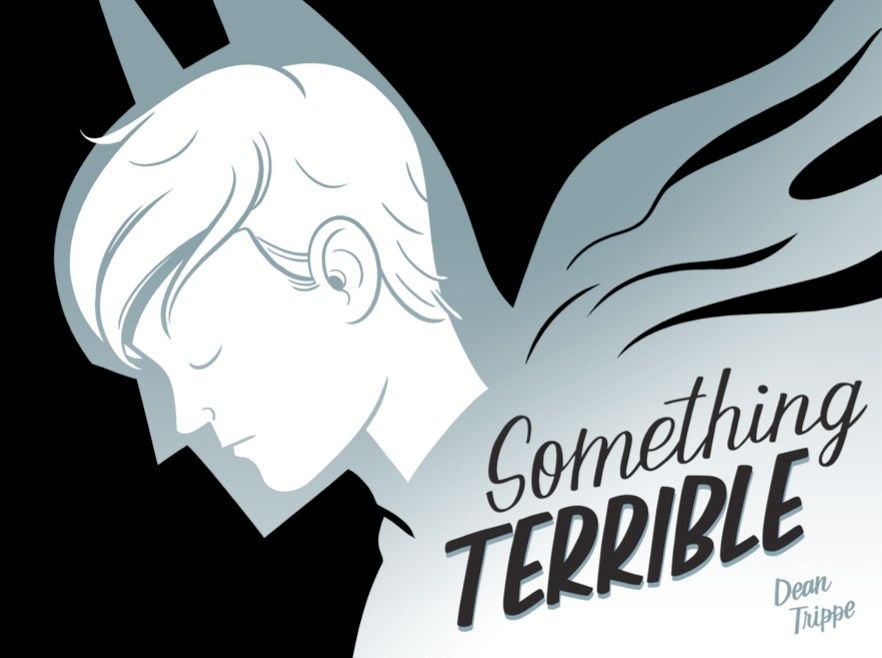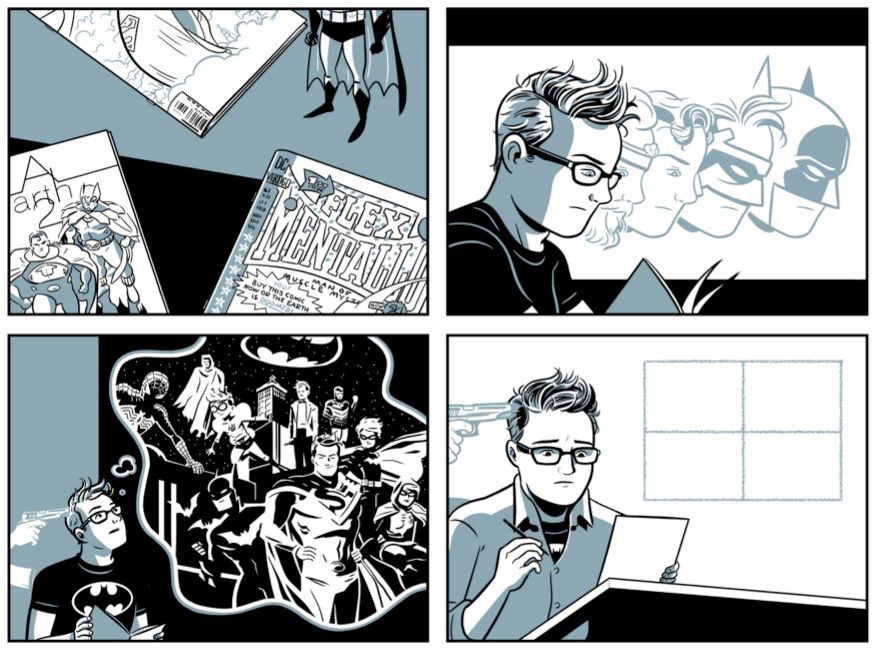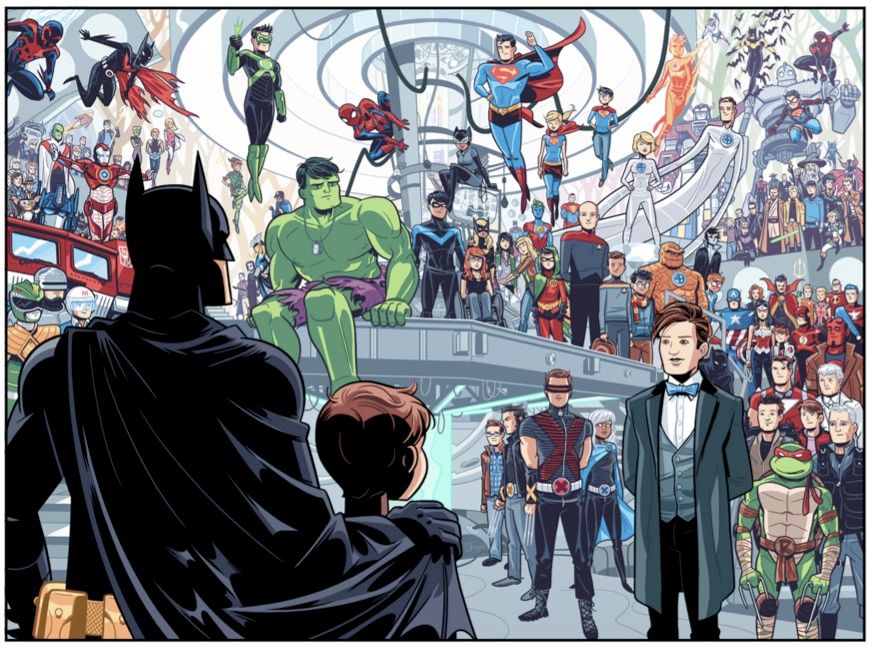What is the most basic, most fundamental function that a hero performs, one so integral it can be used as a way of defining the term hero? There are several ways to answer that question, of course, but one would be the act of saving others.
By that definition then, Batman is most certainly a hero, and not merely because of all the fictional women he's saved from attempted muggings or all the times he's pulled Robin out of death traps. Batman has saved real people, too, despite the fact that character isn't himself real in one of the stricter senses of the word.
He saved Dean Trippe, and Trippe's phenomenal autobiographical comic Something Terrible tells the story of how it happened.
If the contemplation on the reality of superheroes and their interaction with our world sounds like the sort of thing Grant Morrison might meditate on in one of his comics, it probably should: As Trippe's narrative nears its climax, there's a panel of a trio of Morrison's works that address the subject, followed by an image of Trippe's in-comic avatar reading about Morrison's JLA.
In the end, Batman need not be a living, breathing, sweating, flesh-and-blood person to save one of us. He can provide the exact metaphor to help frame a thought process a real person might need to cope with something terrible, as he does in Trippe's case: an example of someone who suffered a tragedy as a child, but nevertheless grew up to be the pinnacle of human achievement, the greatest and the coolest of the superheroes.
He can also provide a young artist with a particular direction in life, pointing toward a medium of expression. He can give a father something he and his son can bond over. And he, like other colorful figures of fantasy — comic book, cartoon, film or otherwise — can provide a much-needed world of escapism, something I imagine Batman and his ilk have done to help save most of Something Terrible's readers in some small way in the past, even if they never needed saving from something as terrible in nature or magnitude from that the young Trippe needed (there's a reason that the climactic image of Trippe's comic, the "You'll be safe here" spread, has already made the rounds on the Internet, and become such a resonant image).
Something Terrible is a 14-page digital comic, told almost entirely in a series of square pages divided precisely into four panels a piece, with just two exceptions. It's black and white — or black and white and blue, really — with color only appearing in a Wizard of Oz-like usage.
That coloring, that almost machine-like precision to the panels and the perfectly finished, pristine look of the artwork evokes the feel of a Daniel Clowes or Adrian Tomine comic.
Within those grids, Trippe tells a story of a young boy who suffers sexual abuse that haunts him more or less his entire life, up to the point at which he creates this comic. The way Trippe presents it, though, is a sort of master class in subtlety — perhaps too subtle in places, as we'll get to in a few paragraphs — providing a minimal amount of necessary visual information, and little in the way of dialogue.
The abuse is depicted on the second page, one of the book's many four-panel grids. In the first panel, we see a larger, more aggressive shadow on the wall, reaching for a smaller, frightened shadow, and the words "If you tell anyone ..." In the second, we see a pair of boy's underwear on the floor, and the words "... I'll kill your family." In the third, a young boy is brought to the police department, where a worried-looking officer awaits him from behind a large desk. In the fourth, the boy seems to angrily avoid looking at a pair of dolls or puppets an adult holds before him.
Years pass on the next page, and the boy meets Batman, a character that not only fascinates and obviously brings him some joy, but also helps him feel stronger.
But that isn't the happy ending, as one night while watching a crime show in bed, the boy hears dialogue referring to a "cycle of abuse" in which "the victim becomes the abuser," and, suddenly, a phantom, third arm appears from the boy's shoulder, pointing a gun at the boy's temple. That arm and that gun stay with the character as he grows to adulthood, becomes a professional comics artist and has a son of his own, and it doesn't go away until an equally phantom Batman appears and snatches it away, saying simply, "No guns."
The final page of the comic, a long-ish prose piece by Trippe telling the story behind Something Terrible, isn't entirely necessary to reading the strip, although it does function as a sort of key to unlocking all the more subtle images in that comic (like the exact circumstances of the abuse, and the meaning of the phantom gun arm, which was actually a lot more literal an image than I took it to be).
I'm glad Trippe included it, as the intimation that this is a true story — aside from looking a lot like Trippe, there's a panel where we see the protagonist at a table sketching at a comics convention, and his name plate reads "Dean Trippe" — naturally raises questions a reader and/or a fan of Trippe's work might have. But, again, it's not entirely necessary: Before one gets to it, Something Terrible is a story of a young boy who suffers something terrible, and then meets a character that helps make sense of it and his life in a variety of ways, literally so in one sequence in which Batman appears in Doctor Who's police box to take him to a safe place.
That climax is a pretty powerful depiction of wish fulfillment and as much as a metaphor as it may be, it can't be overstated that, in the story, Batman and heroes in general don't function merely as metaphors.
Batman may be fictional, but so too are some of the demons that haunt Trippe, like the crime drama-born fear that he's doomed to become an abuser himself. But Batman is the more powerful fiction, the one that combats and defeats the other fictions, because Batman is a more true fiction.
It's heady, powerful stuff, swiftly and elegantly conveyed in Trippe's signature art style. I've been a fan of Trippe's work for a long time now, and, as an artist, he's something of an Internet darling, thanks to his participation in the Project: Rooftop website, which he and Chris Arrant (say, that name sounds familiar) created to showcase costume design.
I've long liked what I saw of Trippe's artwork and design chops there, so much so that when he announced Something Terrible, a webcomic that is being slowly serialized two panels at a time or being sold for 99 cents, I actually bought it, which I bring up only as a way of demonstrating my recommendation for it. See, I'm an inveterate Luddite, and I hate reading comics digitally, and have only reviewed comics I've read electronic review copies of in rather rare circumstances. I've never actually bought a digital comic of any kind in my life. But I bought this one.
And I'm glad I did. As anyone who's seen Trippe's sketches and drawings online could have predicted, he is an extremely talented designer, draftsman and storyteller.
What I couldn't have predicted, though, is just how great a cartoonist he really is. Here he's taken what had to be one of most difficult of stories to tell — "I don't waste my time on scum like you," DC Co-Publisher Dan DiDio has Batman perhaps over-honestly tell a child pornographer in a story he wrote in the most recent issue of Batman: Black and White — and told it so skillfully, so gracefully that it looks effortless.
At the risk of sounding overly glib about a story that starts with a real-world tragedy, Something Terrible is truly something special, and easily one of the best comics I've read this year.



